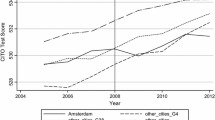Abstract
Controversy surrounds the recent finding that college entrance exams are lower today than they were twenty years ago, but little empirical evidence has been offered in the debate. This paper uses cross-sectional regression analysis to examine the decline in SAT scores between 1972 and 1983. Three explanations are tested: the changing social environment, the financial resources devoted to education, and the emergence of militant teacher unions. The results show teacher unionism to be the most significant factor in the decline in scores.
Similar content being viewed by others
References
Angoff, William H. “The College Board Admissions Testing Program: A Technical Report on Research and Development Activities Relating to the Scholastic Aptitude Test and Achievement Tests.” College Entrance Examination Board, New York, 1971.
Beaton, A.E., T. Hilton, and W.B. Schrader. “Changes in the Verbal Abilities of High School Seniors, College Entrants, and SAT Candidates between 1960 and 1972.” College Entrance Examination Board, New York, 1977.
Belasco, James A. and Joseph A. Alluto. “Organizational Impacts of Teacher Negotiations.”Industrial Relations 9 (October 1969): 67–79.
Breland, H.M. “Family Configuration Effects and the Decline in College Admissions Test Scores: A Review of the Zajonc Hypothesis.” College Entrance Examination Board, New York, 1977.
Chall, J.S., S.S. Conrad, and S.H. Harris. “An Analysis of Textbooks in Relation to Declining SAT Scores.” College Entrance Examination Board, New York, 1977.
Coleman, James. “Public Schools, Private Schools and the Public Interest.”The Public Interest 64 (Summer 1981): 19–30.
College Entrance Examination Board. “On Further Examination: Report of the Advisory Panel on the Scholastic Aptitude Test Score Decline.” College Entrance Examination Board, New York, 1977.
Cresswell, Anthony and F. Spargo. “Impacts of Collective Bargaining Policy in Elementary and Secondary Education: A Review of Research.” Paper presented at the American Educational Research Association Annual Meeting, 1980.
Doyle, Dennis P. and Terry W. Hartle. “The Federal Government and the Schools: Where Do We Go From Here?”Journal of Contemporary Studies 6 (Winter 1983).
Eberts, Randall W. “Collective Bargaining and Teacher Productivity: The Effect on the Allocation of Teacher Time.”Industrial and Labor Relations Review (Forthcoming).
_____ and Joe A. Stone.Unions and Public Schools. Lexington, Mass.: Lexington Books, 1984.
Ferguson, R.L. and E.J. Maxey. “Trends in the Academic Performance of High School and College Students.”ACT Research Report, no. 70. New York: American College Testing Program, 1976.
Hanushek, Eric. “Teacher Characteristics and Gains in Student Achievement: Estimation Using Micro Data.”American Economic Review 61 (May 1971).
Jackson, R. “An Examination of Declining Numbers of High-Scoring SAT Candidates.” The College Entrance Examination Board, New York, 1977.
Jencks, Christopher and James Crouse. “Should We Replace the SAT?”The Public Interest 67 (Spring 1982): 21–25.
Johnson, Susan M.Teacher Unions in Schools. Philadelphia: Temple University Press, 1984.
Kurth, Michael M. “The Growth of Unionism in the Public Sector.” Ph.D. dissertation, Virginia Polytechnic Institute and State University. Blacksburg, VA, 1982.
_____ “Public Employees in Political Firms.” InNew Approaches to Labor Unions, ed. Joe D. Reid. London: JAI Press, 1983.
Lerner, Barbara. “American Education: How Are We Doing?”The Public Interest 69 (Fall 1982): 59–82.
Modu, C., and J. Stern. “The Stability of the SAT-Verbal Score Scale.” College Entrance Examination Board, New York, 1976.
Moore, William J. and Ray Marshall. “Growth of Teachers’ Organizations: A Conceptual Framework.”Journal of Collective Negotiations 2 (1973): 271–297.
Munday, L.A. “Declining Admissions Test Scores.”ACT Research Report, no. 71. New York: American College Testing Program, 1976.
National Commission on Excellence in Education. “A Nation at Risk: The Imperative for Educational Reform.” Washington, D.C., April 1983.
Pascal, Anthony H. “The Hidden Cost of Collective Bargaining in Local Government.”Taxing and Spending (Spring 1980): 31–39.
Reid, Joe D. and Michael M. Kurth. “The Importance of Union Security to the Growth of Unionism.” Center for Study of Public Choice Working Paper, George Mason University, December 1983.
_____. “The Organization of State and Local Governmental Employees: A Comment on Dalton.”Journal of Labor Research (Spring 1984): 191–99.
Rutter, Michael.15,000 Hours: Secondary Schools and Their Effects on Children. Cambridge: Harvard University Press, 1981.
Schlety, Philip C. and Victor S. Vance. “Do Academically Able Teachers Leave Education? The North Carolina Case.”Phi Delta Kappan 63 (October 1981): 106–12.
Schramm, W. “Television and the Test Scores.” The College Entrance Examination Board, New York, 1976.
Summers, A.A. and B.L. Wolfe. “Do Schools Make a Difference?”American Economic Review 67 (September 1977): 639–52.
Victor, R.B.The Economic Effects of Teachers Unions: An Appraisal. Santa Monica, CA: Rand Corporation, 1978.
Author information
Authors and Affiliations
Additional information
I wish to thank David Laband, Henry Butler, and Charles Baird for their helpful comments. I am also grateful to the Shearman Foundation for its financial support and to the College Board for making available its data. Of course, none of the above are responsible for any errors, nor do they necessarily agree with my methods or conclusions.
Rights and permissions
About this article
Cite this article
Kurth, M.M. Teachers’ unions and excellence in education: An analysis of the decline in SAT scores. Journal of Labor Research 8, 351–367 (1987). https://doi.org/10.1007/BF02685219
Issue Date:
DOI: https://doi.org/10.1007/BF02685219




